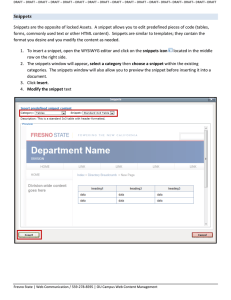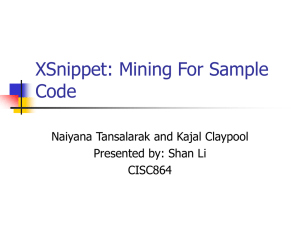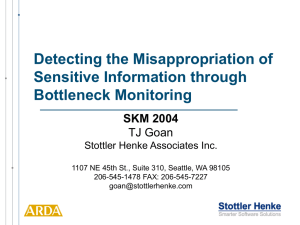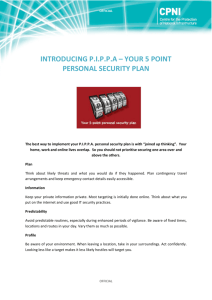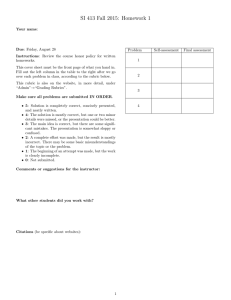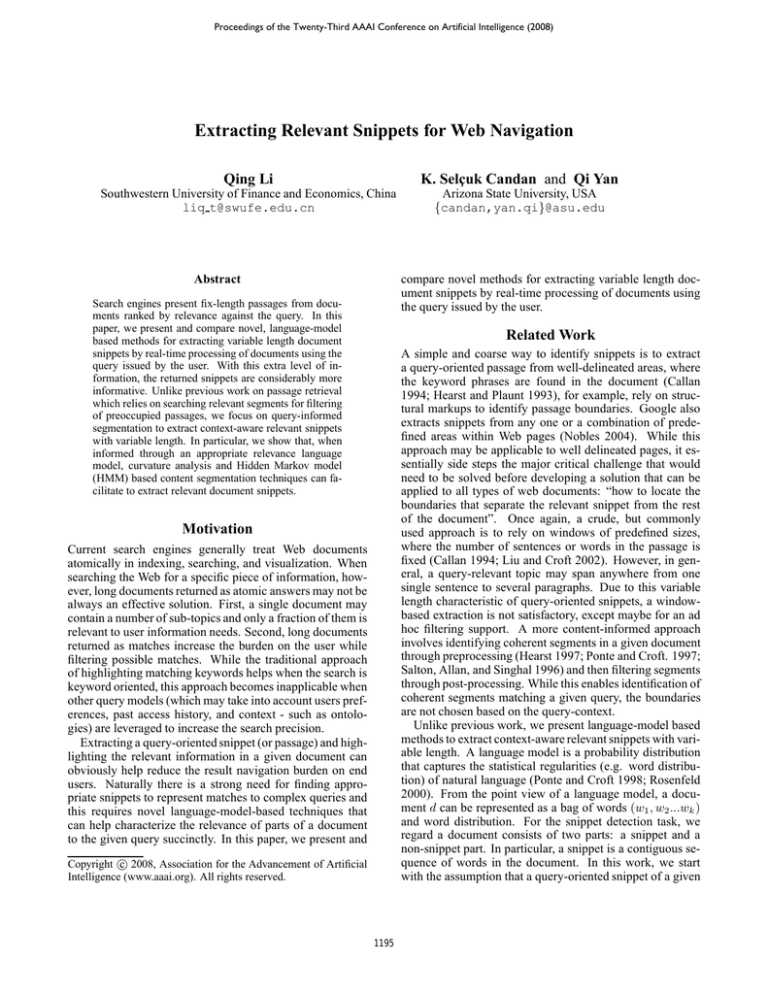
Proceedings of the Twenty-Third AAAI Conference on Artificial Intelligence (2008)
Extracting Relevant Snippets for Web Navigation
Qing Li
K. Selçuk Candan and Qi Yan
Southwestern University of Finance and Economics, China
liq t@swufe.edu.cn
Arizona State University, USA
{candan,yan.qi}@asu.edu
compare novel methods for extracting variable length document snippets by real-time processing of documents using
the query issued by the user.
Abstract
Search engines present fix-length passages from documents ranked by relevance against the query. In this
paper, we present and compare novel, language-model
based methods for extracting variable length document
snippets by real-time processing of documents using the
query issued by the user. With this extra level of information, the returned snippets are considerably more
informative. Unlike previous work on passage retrieval
which relies on searching relevant segments for filtering
of preoccupied passages, we focus on query-informed
segmentation to extract context-aware relevant snippets
with variable length. In particular, we show that, when
informed through an appropriate relevance language
model, curvature analysis and Hidden Markov model
(HMM) based content segmentation techniques can facilitate to extract relevant document snippets.
Related Work
A simple and coarse way to identify snippets is to extract
a query-oriented passage from well-delineated areas, where
the keyword phrases are found in the document (Callan
1994; Hearst and Plaunt 1993), for example, rely on structural markups to identify passage boundaries. Google also
extracts snippets from any one or a combination of predefined areas within Web pages (Nobles 2004). While this
approach may be applicable to well delineated pages, it essentially side steps the major critical challenge that would
need to be solved before developing a solution that can be
applied to all types of web documents: “how to locate the
boundaries that separate the relevant snippet from the rest
of the document”. Once again, a crude, but commonly
used approach is to rely on windows of predefined sizes,
where the number of sentences or words in the passage is
fixed (Callan 1994; Liu and Croft 2002). However, in general, a query-relevant topic may span anywhere from one
single sentence to several paragraphs. Due to this variable
length characteristic of query-oriented snippets, a windowbased extraction is not satisfactory, except maybe for an ad
hoc filtering support. A more content-informed approach
involves identifying coherent segments in a given document
through preprocessing (Hearst 1997; Ponte and Croft. 1997;
Salton, Allan, and Singhal 1996) and then filtering segments
through post-processing. While this enables identification of
coherent segments matching a given query, the boundaries
are not chosen based on the query-context.
Unlike previous work, we present language-model based
methods to extract context-aware relevant snippets with variable length. A language model is a probability distribution
that captures the statistical regularities (e.g. word distribution) of natural language (Ponte and Croft 1998; Rosenfeld
2000). From the point view of a language model, a document d can be represented as a bag of words (w1 , w2 ...wk )
and word distribution. For the snippet detection task, we
regard a document consists of two parts: a snippet and a
non-snippet part. In particular, a snippet is a contiguous sequence of words in the document. In this work, we start
with the assumption that a query-oriented snippet of a given
Motivation
Current search engines generally treat Web documents
atomically in indexing, searching, and visualization. When
searching the Web for a specific piece of information, however, long documents returned as atomic answers may not be
always an effective solution. First, a single document may
contain a number of sub-topics and only a fraction of them is
relevant to user information needs. Second, long documents
returned as matches increase the burden on the user while
filtering possible matches. While the traditional approach
of highlighting matching keywords helps when the search is
keyword oriented, this approach becomes inapplicable when
other query models (which may take into account users preferences, past access history, and context - such as ontologies) are leveraged to increase the search precision.
Extracting a query-oriented snippet (or passage) and highlighting the relevant information in a given document can
obviously help reduce the result navigation burden on end
users. Naturally there is a strong need for finding appropriate snippets to represent matches to complex queries and
this requires novel language-model-based techniques that
can help characterize the relevance of parts of a document
to the given query succinctly. In this paper, we present and
c 2008, Association for the Advancement of Artificial
Copyright Intelligence (www.aaai.org). All rights reserved.
1195
of the relevant portion of the text of the given document.
Previous research (Jiang and Zhai 2004; Zajic, Dorr, and
Schwartz 2002) also study extraction of a single snippet
from a given document regardless of the document length.
One long document, however, might be insufficient to be
represented by a single relevant snippet. Our goal is to provide a flexible mechanism to automatically decide multiple
relevant snippets to necessarily represent the document content. In the next section, we present text segmentation-based
schemes, which neither requires fixed size passages nor requires user feedback as in (Jiang and Zhai 2004).
In the following sections, we present two approaches for
snippet extraction using relevance models. The first approach relies on text segmentation using curvature analysis (Qi and Candan 2006), while the other is based on Hidden Markov Model (HMM) for detecting boundaries between relevant and irrelevant parts of a given document. For
both, we assume that p(w|Mr ) and P (w|Mr̄ ) are obtained,
thereby how to estimate these parameters is discussed.
Figure 1: An example of curvature analysis based snippet detection: the x-axis represents the sequence number
of words, while the y-axis represents the relevance of each
word to the snippet based on the language model. The
shaded area marks the boundaries of a relevant snippet in
the document
Extraction through Curve Analysis
document can be generated with a previously unknown relevance model, Mr . Furthermore, the non-snippet part of the
document can be generated by an irrelevance model, Mr̄ .
Mr (Mr̄ ) captures the probability, P (w|M ), of observing a
word in a document that is relevant (irrelevant) to the query.
For the irrelevance model, estimating probability,
P (w|Mr̄ ), of observing a word, w, in a document that is irrelevant is relatively easy: for a typical query, almost every
document in the collection is irrelevant. Therefore, irrelevance (or background) model can be estimated as follows:
P (w|Mr̄ ) =
cfw
coll size ,
In order to create a relevance language curve, we interpret
the probability, p(w|Mr ), as the degree of similarity between the word, w, and the query. Similarly, P (w|Mr̄ ), is
the probability of observing a word, w, in a document that
is irrelevant to the query-relevant snippet. Based on these
two, we map a given document into a curve in 2-dimensional
space, where the x-axis denotes the sequence number of the
words in the document, while the y-axis denotes the degree
with which a given word is related with the snippet. This degree is calculated by subtracting P (w|Mr̄ ) from p(w|Mr ),
as depicted in step 1 of Figure 2. Thus, the mapping is such
that the distances between points in the space represent the
dissimilarities between the corresponding words, relative to
the given query. As shown in Figure 1, the relevance language curve reveals the relationship of the text content of
the document with the required snippet given a user query.
Once a document is mapped into a relevance language
curve, the task of finding the most relevant snippet can be
converted to the problem of finding a curve segment where
the sum of points in y-value is the largest: that is, most words
in that curve are generated by the relevance model Mr .
Note that the curves generated through the language models are usually distorted by various local minima (or interrupts, which break a continuous curve pattern.). For example, due to the approximate nature of the relevance model,
Mr , some relevant words within the snippet may not be
correctly modeled. This may, then, result in local minima in the curve. Such an interrupt is highlighted in Figure 1. Detecting and removing these interrupts is critical for
avoiding over-segmentations. Thus, we first analyze a given
relevance-curve to remove the local minima (interrupts) to
prevent the over-segmentation. After removing the interrupts, we identify and present those with the largest relevance totals as the query-relevant snippets.
This approach can be easily extended for multiple relevant
snippet extraction. In particular, multiple relevant snippets
can be selected based on the the top-n curve segments with
(1)
where cfw is the number of times that word w occurs in
the entire collection, and coll size is the total number of tokens in the collection. Estimating the probability, P (w|Mr ),
of observing a word, w, that is relevant to a query-oriented
snippet is harder. Of course, if we were given all the relevant snippets from all the documents, the estimation of these
probabilities would be straightforward.
In this paper, we present and compare relevance languagemode-based methods for accurately detecting the most relevant snippets of a given document. In particular,
• we adapt the relevance language model (Lavrenko and
Croft 2001), which was originally applied to the tasks
of information retrieval, to the task of query-relevant
variable-length segmentation and segment detection,
• we show that, when informed through an appropriate relevance language model, curvature analysis and HMM
based content segmentation can help extract the most relevant and coherent snippets from a document.
SNIPPET EXTRACTION
Liu and Croft explore the use of language modeling techniques for passage retrieval (Liu and Croft 2002). Unlike
their work, where passages are limited to predefined lengths,
in this paper, our goal is to extract snippets where the length
of the snippet is not fixed but determined based on the size
1196
Input : Document, D, which consists of n words; query, q; relevance
threshold, θ.
Output : Relevant snippet set, S, which consists of s0 , s1 , ...sm ,
where m is the number of relevant snippets
Step 1 : Generate Relevant Language Curve
1.1. CurveQue = ∅;
1.2. for each word wk ∈ D do
P (wk |Mr ) = getRelbyRM (wk, q) ;
P (wk |Mr̄ ) = getN onRelbyRM (wk , q) ;
ck = P (w|Mr ) − P (wk |Mr̄ ) /* compute the relevance of
each word to the query q */
add ck to CurveQue;
Step 2: Identification of Relevant Snippets
2.1. s = ∅;
2.2. CurveCurQue = removeInterpt(CurveQue); /* remove
interrupts from curve */
2.3. s = getM ostRelSeg(CurveCurQue); /* get the most
relevant segment from a curve */
2.4. Return s;
Input : Document, D, which consists of n words; query, q
Output : the most relevant snippet s;
Step 1 : Compute Pre-fixed Parameters in HMM
1.1. words = ∅ ; /* a map structure to save the information
1.2. HM M = ∅; /* HMM structure for a document */
1.3. tM at = ∅ ;/* HMM transition probability matrix */
1.4. oM at = ∅ ;/* HMM output probability matrix*/
/* compute output probability for each word based on RM */
1.5. for each word wk ∈ D do
wk .rel = getRelbyRM (wk , q) ;
wk .nonRel = getN onRelbyRM (wk , q) ;
add wk to words
1.6.tM at = setInitT ranM at() ; /* create transition matrix
based on hidden state transition structure (Figure 4), missing
elements are to be estimated by the BaumWelch algorithm*/
1.7. oM at = setOutptM at(D, words); /* create output
probability matrix based on RM */
Step 2 : Estimate Unknown Parameters in HMM
2.1. HM M = baumwelch(D, tM at, oM at);/* estimate missing
elements in transition matrix */
Figure 2: Relevance Langauge Curve Analysis Algorithm
Step 3 : Extraction of the most Relevant Snippet
3.1. s = viterbi(HM M, D);/* Given document D, find the
best hidden state sequence using Viterbi Algorithm */
3.2. Return s ;
largest sums of points in y-value, or set a threshold θ to automatically select the number of relevant snippets.
Snippet Extraction through HMMs
Figure 3: Snippet Extraction through relevance model based
HMMs
Different from the above approach which maps a given document into a curve which can then be analyzed for segment
boundaries, snippet extraction based on HMMs treats each
document as HMM chains, where a document is an observable symbol chain and there is a hidden state chain revealing
whether the corresponding word is relevant to the query or
not. The HMM based snippet extraction algorithm is present
in Figure 3 and described next.
r1
r
r2
e
Figure 4: Hidden state transition probability from state si to
state sj for a single snippet extraction
Representation of a Document as HMM A given document can be modeled as a sequence of words, where different parts are generated using either the relevance model or
the irrelevance model. Apparently, before these two parts
are actually identified, we do not know when the switch between the generative models occurs; i.e., the process which
governs the switch between the two models is hidden. If
we regard the status of words generated by different language models as the hidden status and treat the words themselves as a set of observable output symbols, the task of extracting query-oriented snippets is converted into the wellknown HMM evaluation problem (Jiang and Zhai 2004;
Rabiner 1989).
As aforementioned, there are two types of hidden states:
relevant and irrelevant. To extract one maximal snippet from
a document, we need to extend the HMM by breaking the
relevant status into two sub-statuses: r̄1 ( an irrelevant state
before the relevant state) and r̄2 (an irrelevant state after the
maximal snippet). To ensure the extraction of at least one
relevant snippet from the document, the HMM needs to contain an end state e as shown in Figure 4, which forces the
HMM to visit the relevant state r to extract one snippet.
Snippet Boundary Detection through HMM The snippet boundary detection task is then to find the sequence of
hidden states that is most likely to have generated the observations (text) given the observed sequence of output symbols
(words). Given a document, d, the probabilistic implementation of the intuition above can be expressed as follows:
s∗ = arg maxs1 s2 ···sn p(s|d),
where S denotes the sequence of states and si ∈ {r, r̄} denotes a hidden state for the ith word, wi . Using Bayes’ rule,
this can be rewritten
s∗ = arg maxs1 s2 ···sn
p(d|S)p(S)
.
p(d)
Since we build HMM for each document, and the relevant
snippets are extracted from each document individually, the
probability to generate a document d, p(d), is a relative constant to all the segments in this document. The equation can
be further simplified as
1197
Table 1: Dataset used for evaluation
Avg. length of ground truth snippet
# of documents in collection
Avg. length of rel. documents
# of queries for evaluation
s∗ ≈ arg maxs1 s2 ···sn p(d|S)p(S).
Since a given document, d, can be represented as a first
order Markov chain, we can rewrite the above equation as
s∗ = arg maxs1 s2 ···sn p(S)
= arg maxs1 s2 ···sn
n−1
Q
n−1
Q
p(wi+1 |si+1 )
149 words
226,087
521 words
80
• As with most language modeling approaches, including
(Liu and Croft 2002; Ponte and Croft 1998), we calculate the probability, p(w|d), that the word, w, is in a
given document, d, using a maximum likelihood estimate,
smoothed with the background model:
i=1
p(si+1 |si )p(wi+1 |si+1 ).
i=0
While this problem can be solved using the well-known
Viterbi algorithm (Rabiner 1989), in order to apply Viterbi,
we first need to get the parameters of the HMM; that is,
the we need to identify output and transition probabilities,
p(wi+1 |si+1 ) and p(si+1 |si ). Once the output probabilities
are computed, we can rely on the iterative Baum-Welch algorithm (Rabiner 1989) to discover the transition probabilities of the HMM from the current document. However, we
first need to discover the output probabilities discussed in
the following section.
P (w|d) = λPml (w|d) + (1 − λ)Pbg (w)
cfw
+ (1 − λ) coll.size
.
= λ Ptf (w,d)
tf (v,d)
(2)
v
Here, tf (w, d) is the number of times the word, w, occurs
in the document, d. The value of, λ, as well as the number
of documents to include, Rq , are determined empirically.
• Finally, for each word in the retrieved set of documents,
we calculate the probability that the word occurs in that
set. In other words, we calculate, P (w|Rq ) and we use
this to approximate P (w|Mr ) :
Estimating the Relevance Parameters of the RL
Model
Both of the above snippet detection approaches require identification of relevance parameters of the RL model. As discussed before, p(wi |r̄) can be easily estimated by equation 1. Estimation of p(wi |r), however, is not straightforward. One way to achieve this can rely on user feedback (Jiang and Zhai 2004). Jiang and Zhai propose to
estimate p(wi |r) using user feedback to compute p(wi |r).
We argue that user feedback is in many cases too costly and
hard to collect from Web users. Instead, we propose our relevance language model to compute the output probability,
p(wi |r). Next, we show how to compute p(wi |r) from the
relevance language model without requiring any user feedback. In a typical setting, we are not given any examples
of the relevant snippets for estimation. Lavrenko and Croft
propose to address this problem by making the assumption
that the probability of a word, w, occurring in a document
(in the database) generated by the relevance model should be
similar to the probability of co-occurrence (in the database)
of the word with the query keywords. More formally, given
a query, q = {q1 q2 ...qk }, we can approximate P (w|Mr )
by P (w|q1 q2 ...qk ). Note that, in this approach, queries and
relevant texts are assumed to be random samples from an
underlying relevance model, Mr , even though in general the
sampling process for queries and summaries could be different. Following the same line of reasons, we estimate the relevance probability, P (w|Mr ), in terms of query keywords.
In particular, to construct the relevance model Mr , we build
on (Lavrenko and Croft 2001) as follows:
P (w|Mr ) ≈ P (w|Rq ) =
P
P (w|d)P (d|q).
d∈Rq
(3)
Since the number of documents is very large, the value
of p(d|q) is quite close to zero which guarantees the sum
of over all documents is one. Therefore, unlike (Lavrenko
and Croft 2001), we only select documents with the highest
p(d|q) while computing Equation 2. We expect this to both
save execution time and help reduce the effects of smoothing.
EXPERIMENTAL EVALUATION
To gauge how well our proposed snippet identification approach performs, we carried out our experiments on a data
set extracted from TREC DOE (Department of Energy) collection. This collection contains 226,087 DOE abstracts
with 2,352 abstracts related with 80 queries2 . The relevant
abstracts with 80 queries are regarded as the ground truth
(relevant snippets) because we believe that these short abstracts with an average length of 149 words are compact and
highly relevant to the queries. In particular, the proposed
approaches were compared with baseline methods in several
tasks including extracting the most relevant snippet.
We randomly selected irrelevant abstracts and concatenated them with relevant abstracts to create long documents
with a constraint being that each long document has only
one relevant abstract. A detailed description of the dataset is
presented in Table 1.
• We use the query, q, to retrieve a set of highly ranked documents Rq . This step yields a set of documents that contain most or all of the query words. The documents are,
in fact, weighted by the probability that they are relevant
to the query.
2
These queries are title of topics for TREC Ad hoc Test Collections (http : //trec.nist.gov/data/test coll.html). There are
200 topics for Ad hoc test, however the DOE abstracts only related
with 80 of them.
1198
Baseline Methods
Table 2: Performance of alternative methods
In addition to the curvature analysis and HMM based methods to extract relevant snippets, we also implemented two
baseline methods. The first method, FS-Win, is commonly
applied to present snippets in the search-result pages (Nobles 2004). Given a window size k, we examine all k word
long text segments and select the one which has the most occurrences of the query words to be the most relevant. In our
experiments, the window size k is set to about 149 words,
the average word length of the ground truth snippets for the
dataset (Table 1). Without any knowledge about the length
of the relevant snippet in each document, the best the system
can do is to choose on that can perform well on average. We
believe the true average relevant snippet length is an optimal
value, and is the best setting that the system can choose for
FS-Win method. Actually, this gives it an unrealistic advantage and it can be regarded as a strong baseline.
The second is COS-Win method which is able to extract
the variable-length text segments as relevant snippets at the
query time proposed by Kaszkiel and Zobel. In particular,
the text segments of a set of predefined lengths are examined for each document, and the one with the highest cosine similarity with the query is selected as the most relevant snippet. In both baseline methods, we followed the example of (Kaszkiel and Zobel 2001) by using text segments
starting at every 25th word instead of every word in a document, to reduce the computation complexity. As witnessed
by Kaszkiel and Zobel, starting at 25-word intervals is as
effective as starting at every word.
Given the identified snippets, we computed precision, and
recall values as follows: Let Ls be the length of the ground
truth snippet. Let Le be the word length of the extracted
snippet and Lo be the overlap between the ground truth and
the extracted snippet. Then,
Lo
Le
Recall =
Precision
Recall
F-measure
Time cost (ms/doc)
COS-Win
FS-Win
0.685
0.781
0.415
0.573
0.517
0.661
28.9
17.6
RM-Curve
RM-Markov
0.749
0.879
0.856
0.793
0.799
0.834
33.2
31.5
Table 2 presents the overall performance of alternative
methods. We can see that RM-Markov is the best when we
focus on precision. Based on the recall, on the other hand,
RM-Curve outperforms others. Further analysis of the results (discussed in the next Section) showed that, in general, RM-Curve extracted larger snippets, which correctly
included the ground-truth snippets to achieve high recall, but
reducing the precision. Even though RM-Curve and RMMarkov take advantage of recall and precision, respectively,
overall, under F -measure, RM-Markov performs the best.
While the precision and recall performance of RMMarkov and RM-Curve differed slightly, they both performed significantly better than the fixed window baseline
scheme, both in precision and recall. Thus, we can state
that relevance-model-based methods are able to find queryrelevant snippets with remarkably high (0.79-0.83) precision
and recall.
In terms of time cost, all algorithms perform very fast.
Even though the baseline (FS-Win) is the fastest, the precision and recall gains of RM-Markov and RM-Curve make
them desirable despite their slightly higher computation
time. Note also that, while RM-Markov is more efficient
than RM-Curve, it has the limitation that it can identify a
single snippet from a given document at one time. For identifying top-n relevant snippets, we have to run RM-Markove
method n times to extract multiple relevant snippets. Therefore, if the document contains multiple relevant snippets,
RM-Curve maybe more desirable in terms of execution cost.
Metrics
Precision =
Method
Lo
.
Ls
Effects of Snippet Length
As shown in Figure 5(a), predictably, the precision improved
for all alternative schemes as the size of the relevant portion
of the text increased. However, in Figure 5(b), we see that
the recall for the FS-Win can achieve a high recall only when
the window length matches the length of the actual snippet
almost perfectly. On the other hand, RM-Markov as well as
RM-Curve has highly stable recall rates independent of the
length of the ground truth. Based on the F -Measure, RMHMM performed the best among all methods, then followed
by RM-Curve, FS-Win, and COS-Win. It was surprising
to observe that COS-Win showed the worst performance in
snippet identification, even though as reported in (Liu and
Croft 2002), COS-Win method performs as good as and
sometimes better than the method based on fixed window
size in passage information retrieval, where documents are
segmented into passages, and passages are then ranked according to the similarity with a query, documents are finally
ranked based on the score of their best passage. According
to Figure 5(b), we think the poor performance of COS-Win
in snippet identification is partially because it favors short
Given these, we also computed F -measure values, which
assumes a high value only when both recall and precision
are high.
Overall Performance
Before reporting our experimental results using effectiveness measure (F -Measure,Precision, and Recall), we provide a significance test to show that the observed differences
in effectiveness for different approaches is not due to chance
using t-test. It takes a pair of equal-sized sets of per-query
effectiveness values, and assign a confidence value to the
null hypothesis: that the values are drawn from the same
population. If confidence in the hypothesis (reported as a
p-value) is ≤ 0.05 (≤5%), it typically means the results of
experiments are reliable and convincible. Our t-test showed
that using F -measure as the performance measure, relevance
model (RM) based methods performed better than the baseline methods, at p = 0.001. This is much less than the critical
confidence value (0.05).
1199
(a) Precidsion
(b) Recall
(c) F -Measure
Figure 5: Effect of the snippet length on precision, recall and F -Measure
snippets. Overall, as shown in Figure 5, the methods based
on the relevance model show good performance for identifying variable-length snippets over both baseline methods.
Hearst, M., and Plaunt, C. 1993. Subtopic structuring for
full-length document access. SIGIR.
Hearst, M. 1997. Texttiling: A quantitative approach to discourse segmentation. Computational Linguistics Volume
23, Issue 1.
Jiang, J., and Zhai, C. 2004. UIUC in hard 2004 passage
retrieval using HMMs. TREC.
Kaszkiel, M., and Zobel, J. 1997. Passage retrieval revisited. SIGIR.
Kaszkiel, M., and Zobel, J. 2001. Effective ranking with
arbitrary passages. Journal of the American Society for
Information Science and Technology.
Lavrenko, V., and Croft, W. 2001. Relevance-based language models. SIGIR.
Liu, X., and Croft, W. 2002. Passage retrieval based on
language models. CIKM.
Nobles, R. 2004. Pleased with your google description?
Etips.
Ponte, J., and Croft., W. 1997. Text segmentation by topic.
ECDL.
Ponte, J., and Croft, W. 1998. A language modeling approach to information retrieval. SIGIR.
Qi, Y., and Candan, K. 2006. Cuts: Curvature-based development pattern analysis and segmentation for blogs and
other text streams. conference on Hypertext and hypermedia.
Rabiner, L. 1989. A tutorial on hidden markov models and
selected applications in speech recognition. Proceedings of
the IEEE.
Rosenfeld, R. 2000. Two decades of statistical language
modeling: where do we go from here? Proceedings of the
IEEE.
Salton, G.; Allan, J.; and Singhal, A. 1996. Automatic text
decomposition and structuring. IPM Volume 32 , Issue 2.
Zajic, D.; Dorr, B.; and Schwartz, R. 2002. Automatic
headline generation for newspaper stories. Text Summarization Workshop at ACL.
Effect of Parameter Settings
In this section, we explore two parameters: (1) the size n of
retrieved relevant document set, Rq , in Equation 2 and (2)
the smoothing parameter, λ , in Equation 3.
Based on our experiment results, the performance is stable when the number, n, of the relevant document set is set
to anywhere between 5 to 40 documents. Using fewer than
5 or more than 40 documents has negative effects. In the experiments reported above, we used 15 top-ranked documents
in estimating the relevance model.
Numerous studies have shown that smoothing has a very
strong impact on performance (Lavrenko and Croft 2001;
Ponte and Croft 1998). An important role of smoothing
in the language models is to ensure non-zero probabilities
for every word under the document model and to act as a
variance-reduction technique. In our experiments, however,
we observed that setting the smoothing parameter, λ, to 0.9
obtains the best F -measure. In other words, with almost
no smoothing of the document models, RM-Curve and RMMarkov achieves an ideal result. This is because, when we
estimate the relevance model for a given query, we mix together neighboring document models (Equation 2). This results in non-zero probabilities for many words that do not
occur in the original query and there is less need in smoothing to avoid zeros.
Conclusion
In this work, we have shown how the relevance model techniques can be leveraged to build algorithms for the queryrelevant snippet identification task. Our proposed methods, RM-Curve and RM-Markov, are able to locate a single or multiple query-oriented snippets as needed. We have
demonstrated a substantial performance improvement using
the relevance model base schemes.
References
Callan, J. 1994. Passage-level evidence in document retrieval. SIGIR.
1200

